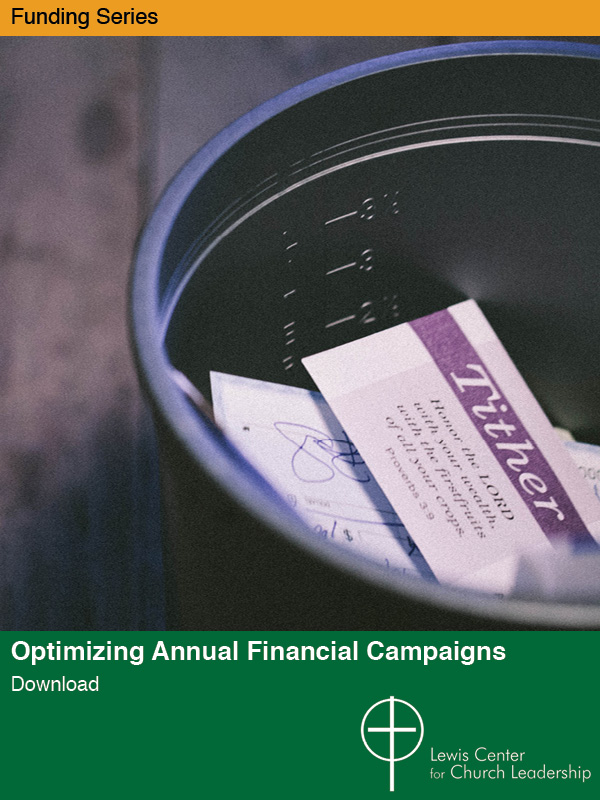Ann Michel of the Lewis Center staff says that forming people for faithful stewardship and extravagant generosity requires more than a single annual sermon. She advocates the development of a stewardship calendar to make sure that different aspects of stewardship receive ongoing attention throughout the year.
As a child, I would roll my eyes when my mother repeated herself again and AGAIN. But as an educator, Mom knew that repetition is the key to learning. As a stewardship professional, I note with some irony that many church leaders complain that their congregations just don’t seem to get it when it comes to giving and stewardship. And yet they never talk about stewardship outside of a commitment campaign conducted in a perfunctory way over a couple of weeks in the fall — a campaign culminating in “The Stewardship Sermon” — the one and only time each year when stewardship is preached from the pulpit.
Creating a culture of generosity within your congregation can’t be done in a single Sunday or even in a month of Sundays. It’s something that needs to be done on an ongoing basis throughout the year.
The Ongoing Challenge of Formation for Giving
Spiritual formation for stewardship and giving requires much more than this. It happens over a lifetime as people grow in faith and discipleship. These days, fewer and fewer people coming into our churches have learned the values of giving and tithing at home. We are bombarded daily with cultural messages contrary to what our Christian faith teaches about money and possessions. We have to constantly invite people into an alternative worldview that attests to the truth that God really does provide for us abundantly, that we are stewards — not owners — of the things that God has entrusted to us, and that giving is more important than acquiring.
Creating a culture of generosity within your congregation can’t be done in a single Sunday or even in a month of Sundays. It’s something that needs to be done on an ongoing basis throughout the year.
Creating a Stewardship Calendar
A stewardship calendar can be an invaluable instrument in planning a more holistic, year-round approach to stewardship. Some wonderful examples of stewardship calendars can be found online, including one by the Episcopal Diocese of West Texas or another by the stewardship division of the Evangelical Lutheran Church in America. These planning templates suggest ways that stewardship themes can be tied to scriptural or liturgical themes across the church year and linked with various aspects of congregational life.
When I worked as the stewardship director at a large church in Washington, DC, I would create a yearly timeline to map out the various parts of our stewardship ministry, not just our pledge campaign. I would ask myself these questions: When was the best time of year to focus on planned giving or stewardship of one’s lifetime assets? When would various special appeals be made? How might stewardship education, including training around financial literacy, fit into the overall church calendar? When would we send thank-yous and giving statements? How would we help people think about stewardship of their time and talents?
My goal was to make sure that all aspects of stewardship received adequate attention, each at the time of year that made sense given the liturgical season and the church’s programmatic calendar. I also wanted to avoid overlapping appeals or competing messages. Once I knew we were going to be focusing on financial literacy in January, sacrificial giving during Lent, and stewardship of time and talents in the early fall, it was much easier to plan appropriate communication and connect our stewardship efforts with preaching, worship, and Christian education.
Start Small
The goal of establishing a holistic, year-round stewardship ministry may sound daunting. But the wonderful thing is that you can start small. Over the next year, experiment with adding something new. Maybe it’s a sermon series on a stewardship-related theme at a time of year totally apart from when you’re asking people to make pledges. I guarantee people will be more receptive to what you have to say if they don’t think it’s a thinly veiled attempt to get more of their money. Or maybe it’s conducting a “Thank-a-thon” to acknowledge the importance of people’s support of the church’s mission and reinforce the connection between generosity and gratitude. You don’t need to do everything on an annual basis. Classes on budgeting or preparing a will might be needed only every so often. But without planning, opportunities might easily fall through the cracks.
Dr. Michel originally wrote this article for the blog series “A New Perspective on Stewardship” hosted on NextChurch.
Related Resources
- Stewardship Resolutions for the New Year by Cesie Delve Scheuermann
- Setting Stewardship Goals for the New Year by Clayton L. Smith
- Theology of Stewardship And Biblical Generosity Video Tool Kit






